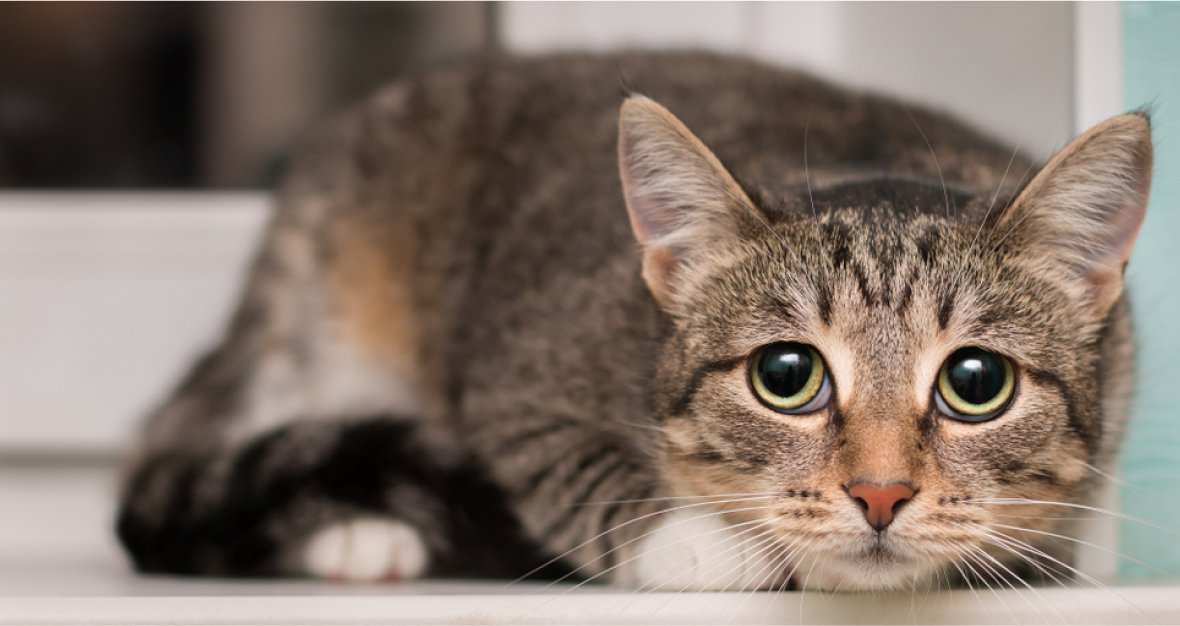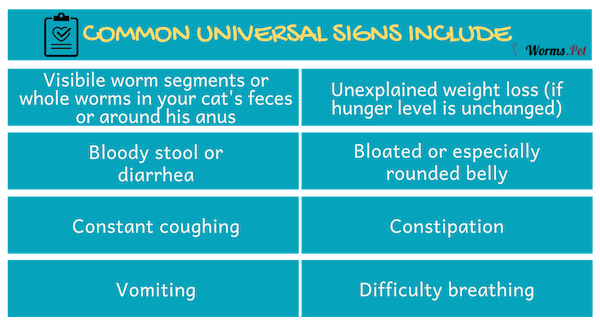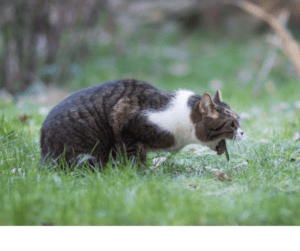Home » Pet Health » Pet Worms » Worms in Cat
Worms in Cat

Parasitic worms are common in cats. The most common cat worms are hookworm, roundworm, lungworm, tapeworm, eye worm, and heartworm. Once these parasites have gone inside the body of the cat, they will begin to multiply rapidly. They will start to live off of the nutrients that your feline friend has.
These parasitic worms can get to felines through contact with parasite eggs, contaminated soil, or infected feces of animals. Moreover, cats can also get worms through a flea or mosquito bite or by eating another parasitic host such as rodents or birds.
Indoor cats can also get parasitic worms, significantly when multiple cats are sharing one litter box. Since cats are fastidious groomers, they can ingest worms from infected things they have contact with whenever they clean themselves using their tongue.
Even though some infected cats will not display any possible symptoms, some of them may still suffer from nonspecific symptoms such as diarrhea, coughing, vomiting, and loss of appetite. Since there are instances where you will not know if your cat is infected or not, it is crucial to have your veterinarian evaluate your cat annually to check for an infestation (Petfeed).

Most parasitic worms are species-specific. However, humans can also get parasitic worms from cats. Accidental infestation can come from contact with infected feces or contaminated soil, leading to lung, eye, heart, and neurological problems.
It is essential to know about the different kinds of parasitic worms in cats to protect yourself and your family once your cat becomes infected with worms.
Transmission
There are various ways where a cat can become infected with parasitic worms. These ways can include stepping or ingesting contaminated soil or feces that contains worms and worm larvae. Moreover, flea, mosquito, or tick bites can also transfer parasitic worms through the worms they carry.
Aside from that, consuming small animals like birds, rodents, or reptiles can also be harmful to cats because worms can often live in these animals. Unfortunately, kittens are most prone to contracting a parasite because of drinking contaminated milk from their mother while nursing.
Identifying which parasite has infected your cat can be challenging since parasitic worms are microscopic, making it impossible to see them with the naked eye. With that, you can find detailed information below about the possible symptoms of having parasitic worms and the specific characteristics of each worm.
As a pet owner, you must remember that your veterinarian can be the best resource if you think your cat might catch parasites. Moreover, regular check-ups are crucial to keeping your cat in good health.
When Should My Dog Get Tested?
Heartworm: Cats should undergo tests before undertaking heartworm preventatives. Since there are still no approved treatment medications for felines, the best way to keep them worm-free is by administering year-round preventions.
Intestinal Worms: According to the Companion Animal Parasite Council (CAPC), all animals should undergo preventive physical exams every 6 to 12 months. Aside from that, there should be fecal examinations by centrifugation at least four times during the first year and at least two times per year after the first year of fecal exams.
ROUNDWORM
The most common intestinal parasites in cats are roundworms. Roundworms can affect around 25-75% of cats, mainly with higher risks in kittens (Cornell University, 2018). Roundworm larvae will hatch in the gastrointestinal tract of the cat. After that, it will move through the liver, muscles, and lungs.
After several weeks, the larvae will migrate back into the intestines to mature into adults. When these adult worms start to reproduce, their eggs will pass through the feces of the cat. With that process, the life cycle of the worm becomes complete (VCA).
Other gastrointestinal roundworms that may infect cats in various parts of the world include:
- Ollulanus tricuspis (found in the stomach)
- Gnathostoma spp
- Physaloptera spp
- Strongyloides spp
Appearance
Roundworms are large-bodied worms, measuring between 3-6 inches in length. These worms often look like spaghetti noodles. Unlike any other intestinal parasites, roundworms do not attach to the wall of the intestine but swim freely within the intestine instead.
Contraction
Cats become infected by swallowing eggs of roundworm larvae. Usually, these eggs are present in the feces of infected cats or the tissues of an atypical host (paratenic host). The most common atypical hosts are cockroaches, earthworms, birds, and rodents. Atypical hosts are not usual hosts for roundworms, so the eggs do not mature into adults and serve as a worm transporter instead. When a cat eats an atypical host, the worms can complete its life cycle.
Roundworm larvae can become enclosed in a cyst and remain dormant inside a cat while in the current body of the host. When a mother cat becomes pregnant, the larvae can break free of the cyst. After that, it can pass to the kittens through the milk of the mother cat.
This process is known as trans-mammary infection and is one of the most common forms of transmission in kittens. Larvae can also be passed on to a kitten during pregnancy through the placenta of the mother cat.
Symptoms
The most common signs of roundworms are depressed appetite, pot-bellied appearance, dull hair coat, diarrhea, vomiting, abdominal discomfort, and poor growth. Having a large number of roundworms can cause life-threatening problems to kittens and older cats.
Cats with a small number of worms may not show any signs or symptoms of infection at all. Instead, you can look for adult roundworms in the feces or vomit of your cat.
Dangerous to Humans?
Roundworms are also dangerous to humans. The most common way of being infected with roundworm is by accidentally ingesting eggs from soil contaminated with dog or cat feces. With that, it is crucial to wash your hands thoroughly and frequently.
HOOKWORM
Hookworms are more frequently present in dogs than in cats. Additionally, this kind of worm in cats is usually less aggressive than any canine species. These worms suck the blood from the tissues of their host and they attach to the intestinal wall with their hook-like mouthpieces (VCA). Hookworms have a long lifespan and can live as long as the life of a cat.
Appearance
The name hookworm came from their hook-like mouthparts. Usually, hookworms use these to anchor themselves to the lining of the intestinal wall.
Hookworms measure about 1/8 inches long, making them look like thin threads. They are so small to the point that you need to use a microscope to see them.
Contraction
Female hookworms can pass hundreds of tiny eggs in the feces of cats. Larvae will then hatch from these eggs and remain alive in the soil for several weeks or months. A cat can eat these larvae while cleaning its paws and body, where the hookworm infection begins.
The larvae will start to travel inside the body of the cat. It will go to the intestines, where they will complete their life cycle. Some larvae may also travel to the trachea or burrow into the skin and migrate to its lungs.
Once this process happens, the cat will start to cough up and swallow the larvae. After that, it will send them to the intestines, where they will mature. It typically takes about 2-3 weeks for female larvae to mature and lay eggs.
Symptoms
The most common signs that a cat can show when infected with hookworm are poor coat, anemia, weight loss, and digested blood in the stool (a black or tarry substance). A large infestation can be indicated by skin irritation and itching, especially of the paws. The hookworm larvae burrow into the skin.
Feline hookworms can feed along the lining of the small intestine. They will suck blood and inject an anti-clotting substance at each feeding site.
This situation prevents the blood from clotting, resulting in blood loss and bleeding. Anemia due to blood loss can be more severe in kittens than in adult cats.
Is It Dangerous to Humans?
Tapeworms usually live in the small intestine while their heads are into the mucous membrane lining of the gastrointestinal tract. They consume the nutrients their host has and break off and pass in the feces of a cat as the segments farthest from the head mature (Cornell University, 2018).
Other tapeworms that occur in some countries include:
- Diphyllobothrium latum (fish are intermediate hosts)
- Spirometra spp (amphibians, reptiles, and rodents are intermediate hosts)
- Dipylidium spp (reptiles are intermediate hosts)
- Joyeuxiella spp (reptiles are intermediate hosts)
- Echinococcus multilocularis (rodents are intermediate hosts)
(International Cat Care)
TAPEWORM
Appearance
Tapeworms are flat, long worms with multiple body segments that often resemble ribbons or tapes. Their small heads have eggs filled in each and are attached to many parts.
The feces of a cat will release these mature segments that contain eggs. Usually, they will look like small grains of rice. Most feline tapeworms measure about 8 inches in length when they become fully grown. However, they can grow up to 20 inches long.
The eggs can often be seen on the hair around the anus of the cat or in the feces.
Contraction
Taenia taeniaeformis tapeworms often need an intermediate host to eat the eggs of a worm first from the environment. A cat will then become infected after eating the intermediate host. Intermediate hosts range from small rodents like mice and rats to birds.
Dipylidium caninum can be transmitted to cats through fleas. Immature flea larvae ingest the eggs of tapeworms and then pass on the infection to a cat once it swallows the flea during grooming.
Symptoms
You may see dried, white-colored worm segments in the feces or stuck to the fur once your cat becomes infected with tapeworms. Cats may bite or clean their backside frequently or consistently drag their bottom across the floor for itching relief.
Is It Dangerous to Humans?
Tapeworms are usually not contagious to humans. However, good hygiene is always the best practice and will virtually eliminate any risk of infection. Frequently wash your hands and shower regularly, and read our Doobert blog for more good hygiene tips!
LUNGWORM
A lungworm is a parasitic worm that usually lives in the airways and lungs of cats. Once a lungworm goes inside the body of a feline, the adult worm will lay eggs. After that, it will hatch into larvae. It will tunnel its way through the lung tissue.
These parasitic worms in cats can cause severe breathing problems as they live in the respiratory system.
Appearance
Lungworms are long, stringy worms that usually measure about 1 to 4 centimeters long. Moreover, female lungworms are significantly longer than male lungworms.
Contraction
Lungworms in cats are most commonly from snails and slugs. Cats can get these parasitic worms by ingesting an infected mollusk or eating a bird or rodent that ate an infected slug or snail.
These parasites will migrate from the intestines to the lungs through the bloodstream once ingested. This process is where they will mature and release eggs in the lungs. The eggs will then pass in the feces of cats, which rodents, birds, snails, or any other animals can ingest. After that, the life cycle becomes complete.
Symptoms
Lungworms can mainly cause severe respiratory and breathing conflicts. Your pet may encounter shortness of breath, feline asthma, wheezing, or coughing. The larvae in the airway may lead to coughing, resulting in an abundance of mucus and difficulty breathing.
If left untreated, symptoms may worsen, including fluid-build-up in the lungs or pneumonia.
Is It Dangerous to Humans?
It is rare to spread lungworms from a cat to a human. However, it is not impossible. It will be best to practice good hygiene by thoroughly washing your hands and bathing. Moreover, avoid consuming raw mollusks.
To learn about the treatment and prevention of worms, check out Cat Treatment and Prevention.
EYEWORM
Eye Worms are whitish parasites that move in a snake-like motion across the eye of a cat. There can be up to 100 eyeworms in the tear ducts and on the conjunctiva under the eyelids (Merck Veterinary Manual). The species is usually present in western North America, and there are more cases around late spring and summer when flies are more active.
Appearance
Adult eye worms are thin, which measure about 0.20 to 0.70 inches in length. You can only see the eggs and larvae of eyeworms by using a microscope from a tear or secretion sample.
Contraction
Flies are the main intermediate hosts, which transfer worm larvae onto the eye of a cat. Eye worm larvae grow in the body of a fly for approximately 30 days and then migrate to its mouth.
The fly will land on the eye of a cat to feed on the secretions of the eyes. After that, the larvae will move out of the mouth. It will then go into the eyes of the new host. In 3-6 weeks, the larvae develop into adults.
Symptoms
Generally, cats will not show any symptoms if there is an infestation of eye worms. However, due to the irritation to the eye, cats may produce more tears, be sensitive to light, and occasionally develop conjunctivitis (inflammation of the mucous membranes of the lids). There may be clouding of the corneas, and if left untreated, it may lead to blindness (Pet Coach).
Is It Dangerous to Humans?
Just like lungworms, eye worms in humans are also extremely rare. However, it is also not impossible. It is uncommon for a human to have a fly near his eyes long enough for the fly to deposit worm larvae.
HEARTWORM
Cats are atypical hosts for heartworms, and most worms will not survive to the adult stage in a cat. Felines will usually have one to three worms and often go undiagnosed.
Even though cats do not usually get hundreds of worms like dogs, immature worms can still cause severe damages, and a condition called the Heartworm Associated Respiratory Disease (HARD) (American Heartworm Society, 1970). HARD is a lung disease that develops an immediate result of heartworms. It causes lethargy, coughing, difficulty breathing, and convulsions in severe cases.
Appearance
Heartworms are foot-long worms that live in the heart, lungs, and associated blood vessels of cats. They measure between 10-12 inches, and they look like cooked strands of spaghetti.
Contraction
Adult female heartworms that live in an infected host will most likely lay eggs that grow into baby worms called microfilaria. When a mosquito bites an infected cat to suck blood, it will ingest the baby worms that will turn into larvae for over 10 to 14 days. When this mosquito bites another cat, that larvae will deposit into the skin of the new cat and migrate into the body through the bite wound.
It will take about six months for the larvae to grow and mature into adults once inside the body of a cat. Once adults, the heartworms can live up to 2 to 3 years in cats.
Symptoms
Cats are not the typical hosts for heartworms because these worms cannot survive to the adult stage in cats. With that, heartworm disease often goes undiagnosed in cats because felines will not show any symptoms.
If they show signs of the disease, symptoms may include vomiting, weight loss, coughing, lack of appetite, or asthma-like attacks. Some cats may also have difficulty walking, have fluid build-up in the abdomen, and seizures. Unfortunately, the first sign can often be sudden collapse or sudden death.
Is It Dangerous to Humans?
Heartworms can also live in any other mammal species, including humans. However, it is also rare but not entirely impossible.
Top 5 Frequently Asked Questions
Yes! There are various cat worms that dogs can get from felines. With that, it is best if you isolate your pets separately once your cat becomes infected with worms. You will need to wait until the worm becomes treated.
Choosing the proper treatment and right worm medicine for cats can speed up the recovery process. Ensure to get it immediately treated so that it cannot infect any other animal.
Lungworms in cats are usually long and stringy. They measure up to 1 to 4 centimeters in length. Moreover, male lungworms are shorter than female lungworms. These worms can cause severe respiratory and breathing issues.
Unfortunately, roundworms can also infect humans. Roundworms can transfer to humans by ingesting the eggs. These worms often affect humans in countries with poor hygiene and sanitation. With that, it is best to wash your hands thoroughly and frequently to prevent roundworm infection.
Heartworms cannot transfer from one cat to another cat directly. Instead, it can pass through other felines by a mosquito bite from an infected mosquito. The risk of getting roundworms is higher when a mosquito is actively feeding.
In the case of a tapeworm infestation, cats may bite at or groom their backside frequently. They may also drag their bottom across the floor for itching relief.
Other Frequently Asked Questions
Kittens and cats can get roundworm infections by eating infected animals, swallowing eggs or larvae present in stools of infected animals, or tissues of birds, rodents, and earthworms. Moreover, cats can also become infected in contaminated places.
Flies are one of the main intermediate hosts that can transfer worm larvae into the eyes of a cat. When a fly lands on a cat, the larvae will move out of the mouth of the fly. It will then go into the eyes of the cat, where the eyeworm infection begins.
Blogs

How To Identify Normal Cat Poop From Worrisome Ones?
Your cat’s poop can tell you many things about its health. Its color, shape, consistency, size, content, and odor can

Hairballs in Cats: What Are They & What Are The Signs?
Hairballs are common in cats. This condition, known as trichobezoar, occurs when hair becomes stuck in the cat’s throat, digestive

Colitis in Cats: What You Should Know
Colitis is one of the many gastrointestinal disorders that affect cats. It is a condition in which the intestine becomes

